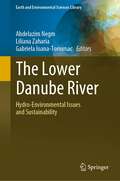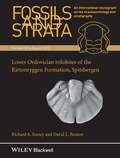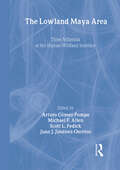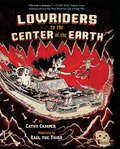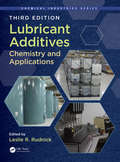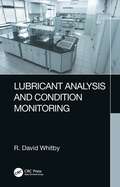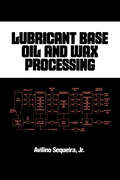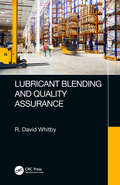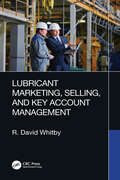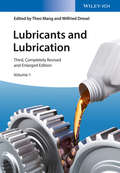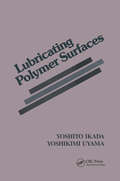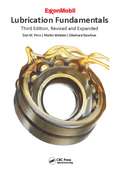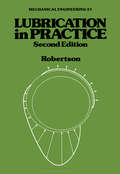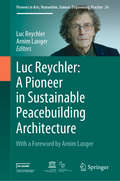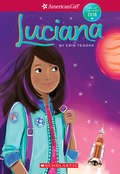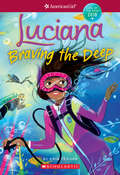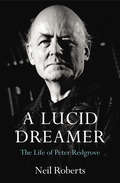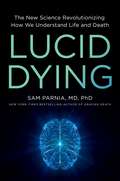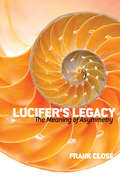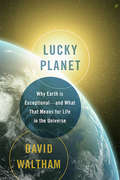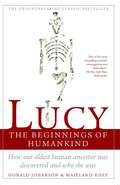- Table View
- List View
The Lower Danube River: Hydro-Environmental Issues and Sustainability (Earth and Environmental Sciences Library)
by Abdelazim Negm Liliana Zaharia Gabriela Ioana-ToroimacThis book provides essential information and recent findings on hydro-environmental issues in the Lower Danube River, particularly its hydrological and hydromorphological processes; physico-chemical features; climate and water-related hazards; and not only the biodiversity and quality but also the sustainable management and governance of its hydro-environment. Accordingly, it presents a broad range of scientific information on the lower sector of the second-longest river in Europe, which holds major economic importance and has been severely impacted by human pressures, especially since the second part of the last century. The engineering works (e.g. dams, reservoirs, levees, channelization, etc.) on the Danube and its tributaries, despite their benefits to society, have altered its flow and significantly reduced its sediment load, with consequences for hydromorphological processes and aquatic ecosystems. These ecosystems have also been affected by pollution from various sources. To promote sustainable management of the Danube River and its watershed, several strategies and measures have been developed by a number of institutions, from the European level to the national and regional levels (commissions, national authorities, non-governmental organizations, etc.). Compared to the upper and middle sectors of the Danube, the lower sector has received less attention in the international scientific literature in terms of hydro-environmental issues. The book fills this gap and provides current and original insights and findings from recent studies conducted by scientists from three countries drained by the Lower Danube River and its tributaries: Bulgaria, Romania and Serbia. This unique book will be of great scientific interest to professional engineers, policy planners and policymakers in the three countries mentioned above, helping them to implement their own sustainable development plans. It also offers a valuable resource for graduate students, researchers and stakeholders.
Lower Ordovician trilobites of the Kirtonryggen Formation, Spitsbergen: Lower Ordovician Trilobites Of The Kirtonryggen Formation, Spitsbergen (Fossils and Strata Monograph Series #59)
by Richard A. Fortey David L. BrutonThis monograph describes early Ordovician (Ibexian:Tremadocian–early Floian) trilobites from Northern Spitsbergen from the section through the Kirtonryggen Formation adjacent to Hinlopen Strait. The Formation is divided into three Members, each with distinct trilobites collectively representing the fullest known succession from the Bathyurid biofacies of the eastern Laurentian carbonate platform. Previous research on the Ordovician of Spitsbergen is summarised and correlations with similar faunas previously described from Canada, Greenland, western Newfoundland, Vermont–New York State, Oklahoma and Missouri are discussed. Taxonomic problems are discussed in detail leading to the recognition of 53 species, of which 15 are new, belonging to 31 genera including four new. Twenty-four taxa are described under open or tentative nomenclature. The lower Member yields the earliest known occurrences of the Illaenoidea, Proetoidea and Scutelluoidea, supporting the hypotheses relating the origin of new major clades to inshore habitats.
Lowland Grassland and Heathland Habitats (Habitat Guides)
by Elizabeth PriceGrasslands are everywhere: agricultural land, playing fields and road verges; but while species-poor, intensively managed grasslands are widespread, colourful semi-natural grasslands and heathlands, buzzing with life, are scarce. These semi-natural habitats are ancient, cultural landscapes, which are of considerable, if not international importance for biodiversity. However, despite targets for the conservation and restoration of these valuable grasslands and heathlands, these habitats continue to decline before our eyes. Lowland Grassland and Heathland Habitats contrasts the uniformity of intensively managed grassland with the diversity of traditionally managed grasslands and heathlands. It examines topics of concern to the ecologist or habitat manager such as causes of the loss and deterioration of these habitats, including inappropriate management, eutrophication and climate change. It then evaluates opportunities for positive change, such as conservation, restoration and creation. A series of case-studies illustrates the pressures on some lowland grassland and heathland habitat types and looks at ways to enhance them for biodiversity. This habitat guide features illustrated species boxes of typical plants and animals, as well as a full species list, a series of projects on the ecology of grassland and heathland species, a colour plate section, up-to-date references and information, and a full glossary. It will provide students and environmentalists with a deeper understanding of the nature and importance of lowland grasslands and heathlands.
The Lowland Maya Area: Three Millennia at the Human-Wildland Interface
by Arturo Gómez-Pompa Michael F. Allen Scott L. Fedick Juan J. Jiménez-OsornioWhat can we learn from the people of the Maya Lowlands? Integrating history, biodiversity, ethnobotany, geology, ecology, archaeology, anthropology, and other disciplines, The Lowland Maya Area is a valuable guide to the fascinating relationship between man and his environment in the Yucatán peninsula. This book covers virtually every aspect of the biology and ecology of the Maya Lowlands and the many ways that human beings have interacted with their surroundings in that area for the last three thousand years. You'll learn about newly discovered archaeological evidence of wetland use; the domestication and use of cacao and henequen plants; a biodiversity assessment of a select group of plants, animals, and microorganisms; the area's forgotten cotton, indigo, and wax industries; the ecological history of the Yucatán Peninsula; and much more. This comprehensive book will open your eyes to all that we can learn from the Maya people, who continue to live on their native lands, integrating modern life with their old ways and teaching valuable lessons about human dependence on and management of environmental resources. The Lowland Maya Area explores: the impact of hurricanes and fire on local environments historic and modern Maya concepts of forests the geologic history of the Yucatán challenges to preserving Maya architecture newly-discovered evidence of fertilizer use among the ancient Maya cooperation between locals and researchers that fosters greater knowledge on both sides recommendations to help safeguard the future The Lowland Maya Area is an ideal single source for reliable information on the many ecological and social issues of this dynamic area. Providing you with the results of the most recent research into many diverse fields, including traditional ecological knowledge, the difficult transition to capitalism, agave production, and the diversity of insect species, this book will be a valuable addition to your collection. As the editors of The Lowland Maya Area say in their concluding chapter: If we are to gain global perspective from the changing Maya world, it is that understanding space and time is absolutely critical to human persistence. Understanding how the Maya have interacted with their environment for thousands of years while maintaining biodiversity will help us understand how we too can work for sustainable development in our own environments.
Lowly Origin: Where, When, and Why Our Ancestors First Stood Up
by Jonathan KingdonOur ability to walk on two legs is not only a characteristic human trait but one of the things that made us human in the first place. Once our ancestors could walk on two legs, they began to do many of the things that apes cannot do: cross wide open spaces, manipulate complex tools, communicate with new signal systems, and light fires. Titled after the last two words of Darwin's Descent of Man and written by a leading scholar of human evolution, Lowly Origin is the first book to explain the sources and consequences of bipedalism to a broad audience. Along the way, it accounts for recent fossil discoveries that show us a still incomplete but much bushier family tree than most of us learned about in school. Jonathan Kingdon uses the very latest findings from ecology, biogeography, and paleontology to build a new and up-to-date account of how four-legged apes became two-legged hominins. He describes what it took to get up onto two legs as well as the protracted consequences of that step--some of which led straight to modern humans and others to very different bipeds. This allows him to make sense of recently unearthed evidence suggesting that no fewer than twenty species of humans and hominins have lived and become extinct. Following the evolution of two-legged creatures from our earliest lowly forebears to the present, Kingdon concludes with future options for the last surviving biped. A major new narrative of human evolution, Lowly Origin is the best available account of what it meant--and what it means--to walk on two feet.
Lowriders to the Center of the Earth (Lowriders #2)
by Cathy Camper Raul The ThirdThe lovable trio from the acclaimed Lowriders in Space are back! Lupe Impala, Elirio Malaria, and El Chavo Octopus are living their dream at last. They're the proud owners of their very own garage. But when their beloved cat Genie goes missing, they need to do everything they can to find him. Little do they know the trail will lead them to the realm of Mictlantecuhtli, the Aztec god of the Underworld, who is keeping Genie prisoner! With cool Spanish phrases on every page, a glossary of terms, and an action-packed plot that sneaks in science as well as Aztec lore, Lowriders to the Center of the Earth is a linguistic and visual delight. ¡Que suave!
LQG for the Bewildered
by Deepak Vaid Sundance Bilson-ThompsonThis primer offers a concise introduction to Loop Quantum Gravity (LQG) - a theoretical framework for uniting Quantum Mechanics (QM) with General Relativity (GR). The emphasis is on the physical aspects of the framework and its historical development in terms of self-dual variables, still most suited for a first, pedagogical encounter with LQG. The text starts by reviewing GR and the very basics of Quantum Field Theory (QFT), and then explains in a concise and clear manner the steps leading from the Einstein-Hilbert action for gravity to the construction of the quantum states of geometry, known as spin-networks, and which provide the basis for the kinematical Hilbert space of quantum general relativity. Along the way the various associated concepts of tetrads, spin-connection and holonomies are introduced. Having thus provided a minimal introduction to the LQG framework, some applications to the problems of black hole entropy and of quantum cosmology are briefly surveyed. Last but not least, a list of the most common criticisms of LQG is presented, which are then tackled one by one in order to convince the reader of the physical viability of the theory. A set of appendices provides accessible introductions to several key notions such as the Peter-Weyl theorem, duality of differential forms and Regge calculus, among others. The presentation is aimed at graduate students and researchers who have some familiarity with the tools of QM and GR, but are intimidated by the technicalities required to browse through the existing LQG literature. This primer aims at making the formalism appear a little less bewildering to the uninitiated and helps lower the barrier for entry into the field.
Lubricant Additives: Chemistry and Applications, Third Edition (Chemical Industries #Vol. 90)
by Leslie R. RudnickThis indispensable book describes lubricant additives, their synthesis, chemistry, and mode of action. All important areas of application are covered, detailing which lubricants are needed for a particular application. Laboratory and field performance data for each application is provided and the design of cost-effective, environmentally friendly technologies is fully explored. This edition includes new chapters on chlorohydrocarbons, foaming chemistry and physics, antifoams for nonaqueous lubricants, hydrogenated styrene–diene viscosity modifiers, alkylated aromatics, and the impact of REACh and GHS on the lubricant industry.
Lubricant Analysis and Condition Monitoring
by R. David WhitbyAlmost all mechanical devices used in every industry require lubrication. Lubricant Analysis and Condition Monitoring explains the benefits of identifying, planning, implementing and using lubricant and machine condition monitoring programmes to extend the lifetimes of both lubricants and machines, to achieve maximum productivity and profitability while reducing impacts on waste and the environment. This book: Offers a comprehensive overview of all types of tests used in lubricant condition monitoring programmes Discusses monitoring the condition of all types of components, machines, equipment and systems used in all industries Considers new and emerging machines, equipment and systems, including electric and hybrid vehicles Suggests which tests to use for each type of machine, equipment or system and, just as importantly, which tests not to use Provides practical examples of how to set up, run and manage condition monitoring programmes and how to achieve significant cost savings through planned and predictive maintenance schedules Gathering vital information that users of lubricants need in one place, this book is of practical use to mechanical, maintenance, manufacturing and marine engineers as well as metallurgists, chemists and maintenance technicians.
Lubricant Base Oil and Wax Processing (Chemical Industries)
by Avilino SequeiraProvides state-of-the-art information on all processes currently used to manufacture lubricant base oils and waxes-offering practical, timesaving solutions for specific on-the-job problems. Furnishes helpful lists of conversion factors, construction cost data, and process licensors, as well as a glossary of essential petroleum processing terms.
Lubricant Blending and Quality Assurance
by R. David WhitbyMany people, including those involved in the manufacturing, marketing and selling of lubricants, believe that blending lubricants is simply a matter of putting one or more base oils and several additives into a tank of some kind and stirring them around to mix them. Blending lubricants that meet customers’ demands requires much more than this. The correct ingredients of the right quality need to be used in precisely controlled quantities. The ingredients need to be tested prior to blending and the finished products need to be tested following blending. The ingredients need to be stored and mixed under carefully controlled conditions. The finished lubricants need to be stored and packaged carefully and then delivered to customers correctly. <P><P>This book discusses all of these issues, describes the different types of equipment used to blend lubricants, provides guidance on how best to use this equipment, and offers tips and techniques to help to avoid problems. It focuses on liquid lubricants. Greases are not discussed, as their manufacture involves very different manufacturing procedures compared with those concerned with liquid lubricants. <P><P>The book starts with descriptions and discussion of the properties and characteristics of the main types of mineral and synthetic base oils, as well as the properties and characteristics of the main types of additives that are used in lubricant formulations. Criteria and methodologies used to design both new and upgraded blending plants are covered next. The types and operation of the equipment used in lubricant blending plants are described and discussed, together with a chapter on how to avoid problems before, during, and after blending. Testing and analysis of base oils, additives, and blended lubricants are covered in two separate chapters. Procedures for quality control and quality management in lubricant blending plants are also discussed in two separate chapters. Types of packages for lubricants are reviewed, together with methods for filling packages and methods for transporting lubricants in bulk. The storage of lubricants and supply chain management is also covered in depth.
Lubricant Marketing, Selling, and Key Account Management
by R. David WhitbyThe global lubricants market exceeds $110 billion, with strong future-estimated annual growth projections. While much has been written about the technical aspects of lubricant development, Lubricant Marketing, Selling, and Key Account Management fills a need for a comprehensive guide on the important commercial aspects of the business, offering unique and valuable insights from a veteran of the industry. It answers questions and offers insights on how to effectively market and sell all types of lubricants, including automotive, industrial, mining, marine, agricultural and aerospace, among others. Covers how and why people and companies buy lubricants. Instructs readers how to research and analyze markets and use the results to plan marketing and sales campaigns and activities. Details how to identify specific target market segments and sell to key lubricant accounts. Discusses how to forecast future demand for lubricants in all types of global markets. This practical book is written for technical and non-technical readers involved in the sale and management of lubricant products and offers hands-on guidance for how to successfully navigate and grow your profitability in this vitally important product sector.
Lubricants and Lubrication, 2 Volume Set
by Mang Wilfried DreselPraise for the previous edition: “Contains something for everyone involved in lubricant technology” — Chemistry & Industry This completely revised third edition incorporates the latest data available and reflects the knowledge of one of the largest companies active in the business. The authors take into account the interdisciplinary character of the field, considering aspects of engineering, materials science, chemistry, health and safety. The result is a volume providing chemists and engineers with a clear interdisciplinary introduction and guide to all major lubricant applications, focusing not only on the various products but also on specific application engineering criteria. A classic reference work, completely revised and updated (approximately 35% new material) focusing on sustainability and the latest developments, technologies and processes of this multi billion dollar business Provides chemists and engineers with a clear interdisciplinary introduction and guide to all major lubricant applications, looking not only at the various products but also at specific application engineering criteria All chapters are updated in terms of environmental and operational safety. New guidelines, such as REACH, recycling alternatives and biodegradable base oils are introduced Discusses the integration of micro- and nano-tribology and lubrication systems Reflects the knowledge of Fuchs Petrolub SE, one of the largest companies active in the lubrication business 2 Volumes wileyonlinelibrary.com/ref/lubricants
Lubricating Polymer Surfaces
by Yoshikimi UyamaA lubricating polymer surface is important, especially in biomedical technologies. Low-friction surfaces enable easy insertion and removal of devices from patients. Earlier approaches were mostly simple applications involving lubricants such as lidocaine jelly, silicone oil, or non-permanent coating with low-friction materials such as polyethylene or fluoroplastics. However, these substances cannot maintain a high degree of slipperiness for the required duration of time. This book describes the principle of lubrication, outlines a variety of methods for attaining a lubricous surface, and describes the characteristics and properties of such lubricous surfaces.
Lubrication Fundamentals, Revised and Expanded
by Don M. Pirro Martin Webster Ekkehard DaschnerCareful selection of the right lubricant(s) is required to keep a machine running smoothly. Lubrication Fundamentals, Third Edition, Revised and Expanded describes the need and design for the many specialized oils and greases used to lubricate machine elements and builds on the tribology and lubrication basics discussed in previous editions. <P><P>Utilizing knowledge from leading experts in the field, the third edition covers new lubrication requirements, crude oil composition and selection, base stock manufacture, lubricant formulation and evaluation, machinery and lubrication fundamentals, and environmental stewardship. The book combines lubrication theory with practical knowledge, and provides many useful illustrations to highlight key industrial, commercial, marine, aviation, and automotive lubricant applications and concepts. All previous edition chapters have been updated to include new technologies, applications, and specifications that have been introduced in the past 15 years. <P><P>What’s New in the Third Edition: <Li>Adds three new chapters on the growing renewable energy application of wind turbines, the impact of lubricants on energy efficiency, and best practice guidelines on establishing an in-service lubricant analysis program <Li>Updates API, SAE, and ACEA engine oil specifications, descriptions of new engine oil tests, impact of engine and fuel technology trends on engine oil <Li>Includes the latest environmental lubricant tests, definitions, and labelling programs <Li>Compiles expert information from ExxonMobil publications and the foremost international equipment builders and industry associations <Li>Covers key influences impacting lubricant formulations and technology <Li>Offers data on global energy demand and interesting statistics such as the worldwide population of nuclear reactors, wind turbines, and output of hydraulic turbines <Li>Presents new sections on the history of synthetic lubricants and hazardous chemical labeling for lubricants <P><P>Whether used as a training guide for industry novices, a textbook for students to understand lubrication principles, or a technical reference for experienced lubrication and tribology professionals, Lubrication Fundamentals, Third Edition, Revised and Expanded is a "must read" for maintenance professionals, lubricant formulators and marketers, chemists, and lubrication, surface, chemical, mechanical, and automotive engineers.
Lubrication in Practice
by W. L. RobertsonThis book will appeal to a broad range of engineers and managers in all sectors of manufacturing engineering, power generation and transport. Drawing on their specialist experience and knowledge, the many contributors show how the careful application of correct lubrication can lead to improved productivity, longer plant and equipment life and higher profits. Throughout the emphasis is on showing what lubricants can do, and how they can best be used. After introductory chapters that summarise the basic theory and the general types and properties of lubricants, there follow eleven chapters that cover such specific applications as diesel and petrol engines, hydraulics, compressors, machine tools and cutting oils. The last two chapters discuss the storage and handling of lubricants, and lubrication planning. The majority of the authors and editors, have worked for Esso Petroleum Company Limited and have a unique range of experience in this area. Many of the authors have contrbuted to advances in techniques for imrproved lubrication in their specialist areas.
Luc Reychler: A Pioneer in Sustainable Peacebuilding Architecture (Pioneers in Arts, Humanities, Science, Engineering, Practice #24)
by Luc Reychler Arnim LangerThis book provides a unique personal perspective on the field of peace research. It not only highlights Luc Reychler’s significant contributions to the theory and praxis of sustainable peacebuilding, but also offers important reflections on the evolution of peace research as an independent discipline. The central concept of this book – and of Reychler’s academic career, for that matter – is sustainable peacebuilding architecture. Reychler introduced this concept in order to draw attention to the architectural principles and considerations that have to be addressed in sustainable peacebuilding processes. Reychler’s work on sustainable peacebuilding architecture has been groundbreaking and has not lost any of its relevance in the twenty-first century. By bringing together Reychler’s seminal texts on sustainable peacebuilding architecture, the current book aims to offer academics, students and policymakers an essential guide to understanding, studying and applying this crucial concept.• Provides a unique personal view of the development of peace research• Lists the necessary building blocks for sustainable peacebuilding• Offers tools for monitoring and evaluating interventions• Discusses the scientific nature and often provocative findings of peace research • Discusses ten lessons learned and the future (Peace Research III)
Luchadores: El testimonio de padres de niños con trastornos neurológicos
by Fundación Luchadores AvaPrólogo de Irene Villa. «Tienen en sus manos un libro sobrecogedor que inquieta pero nos llena de amor y esperanza, es un auténtico alegato de vida, de encontrar la forma y la actitud necesarias para luchar sin descanso y de no rendirse jamás». Irene Villa. Esta es una obra, ante todo, alegre, optimista, motivadora, inspiradora un canto a la vida. Un libro que te hará llorar y reír, y que sacará lo mejor de ti. Te hará ver la vida de otra manera y afrontarla con mayor fuerza y alegría. A través de él vivirás más de once vidas, las vidas de once padres y un abuelo que te contarán cómo afrontan la enfermedad de su hijo. No los oirás quejarse o maldecir su suerte. Te hablarán del amor que sienten por sus hijos, de cómo han cambiado sus vidas, sus prioridades y su forma de pensar. Te enseñarán a afrontar los pequeños o grandes problemas diarios mediante sus propias vivencias y, sobre todo, te irás con una gran lección: que el amor que siente un padre por su hijo todo lo puede. Conocerás la lucha diaria de estos niños que no tienen voz, queson los grandes olvidados de una sociedad atareada que ha perdido sus valores. Niños que con sus grandes sonrisas y sus ganas de vivir son capaces de cambiar a cualquiera que se cruce en su camino y se detenga a conocerlos. ¡Déjate cambiar por ellos!
Luciana: Out Of This World (American Girl: Girl of the Year 2018 #1)
by Erin Teagan Lucy TrumanGet to know American Girl's 2018 Girl of the Year, Luciana, in this first book in her series! Luciana is over the moon—she's going to Space Camp! But when she's picked to lead her team in a robot challenge, instead of rocketing her crew to success she steers them straight into trouble. After that, her teammates don't trust her. In fact, Luci's pretty sure they don't even like her. It's great to be good at science—but Luci learns that it's not enough. If she's ever going to make it to Mars, she's got to be someone her crew can depend on, no matter what.
Luciana: Braving The Deep (girl Of The Year 2018, Bk. 2) (American Girl: Girl of the Year 2018 #2)
by Erin Teagan Lucy TrumanIn her second novel, Luciana is off to youth astronaut training camp! She hopes to be chosen to dive to an underwater habitat where real astronauts train for life in space. But when Luci accuses her diving partner of sabotage, no one believes her and her chances of making the diving team sink fast. Things hit rock bottom when Luci has an underwater crisis. Suddenly, making the dive team isn’t her biggest worry. She’ll have to conquer her fears if she ever wants to make it to Mars. If she can’t, will she have to kiss her dreams of becoming an astronaut good-bye?
A Lucid Dreamer: The Life of Peter Redgrove
by Dr Neil Roberts Peter RedgroveThe work of the poet Peter Redgrove is one of the great unexplored treasures of late twentieth century literature. His prolific output presents an intriguing variety of personae: magician, scientist, lover, psychologist, joker, madman. It is only now, with the publication of his Collected Poems and this biography, that we can see how and why these personae developed - and discover the full depth and range of this visionary writer.Born into an apparently conventional middle-class family that was in reality deeply disturbed, the poet finally emerged: transforming himself from the neurotic, Oedipal young scientist, through a process of mental breakdown, insulin coma therapy, erotic revelation and the discovery of poetic companionship at Cambridge - and particularly his friendship and rivalry with Ted Hughes.Neil Roberts explores the inner story of this emergence, and Redgrove's later development through marriage, family life, the fellowship of the 'Group', alcoholic excess, infidelity and marital breakdown to his triumphant later partnership with Penelope Shuttle. We also discover, for the first time, some darker secrets: his fascination with Aleister Crowley, his damaged and damaging relationship with his father, and the lifelong sexual fetish which he called the 'Game'. Drawing on the poet's intimate journals and correspondence, and interviews with family, friends and colleagues, A Lucid Dreamer tells the exceptionally inward and revealing story of an astonishing creative life.
Lucid Dying: The New Science Revolutionizing How We Understand Life and Death
by Sam ParniaFrom internationally renowned expert in resuscitation and New York Times bestselling author Sam Parnia, MD, PhD, comes a groundbreaking look at what happens to us when we die, based on the largest-ever research study run on recalled experiences of death. Today, for the first time in history, the scientific exploration of death and what happens when we die is real, active and ongoing. Contrary to popular perceptions, this subject is no longer the remit of philosophy, religion, or personal opinion. Truly remarkable scientific discoveries that will fundamentally affect everyone&’s lives now and in the future are taking place, yet very few people are aware of them. Most people—including scientists and doctors—maintain strong beliefs about death and its experience. Those beliefs are rooted in traditional, and often cultural, notions of death. But what if all that we have come to believe about death is fundamentally wrong? What if the paradigm we have been operating within no longer exists? What if death is not the end we thought?Lucid Dying is the first book to share that science. Presenting data derived from multiple groundbreaking studies, Dr. Parnia shows that the entity we refer to as consciousness—our Self—does not seem to become annihilated when we die. In fact, during death, our consciousness vastly expands and leads to a vivid experience that follows a very specific narrative arc. These studies support that there really is a universal experience of death that is meaningful, transcendent, positive, and transformative—not hallucinatory, delusional, or illusory as previously imagined. In his latest book, Dr. Parnia weaves empirical research with gripping stories to show us the truth of how death is not the end we all thought and how anyone can harness the newfound wisdom to lead deeper, more intentional lives.
Lucifer's Legacy: The Meaning of Asymmetry
by Frank Close"This is Frank Close's masterpiece -- his best book, and one of the very best introductions to physics for the layperson. Close is a master expositor." -- The (London) Sunday Times"Close's writing is beguiling, mingling personal and historical anecdote with carefully measured doses of exposition in such a way as to guide the reader painlessly into rather deep intellectual waters." -- Nature "Life, intrinsically related to asymmetries, is the theme of this book, and Close offers us an absorbing and scientifically correct account of symmetry and its deep implications." -- CERN CourierThis thought-provoking work by a physicist and popular science writer explores the origins of asymmetry from the molecular level to that of the universe at large. Frank Close takes the readers on a tour of asymmetry that ranges from the development of human embryos to the mysterious Higgs boson, or "God particle," and ongoing research at Switzerland's CERN laboratory.
Lucky Planet: Why Earth is Exceptional-and What That Means for Life in the Universe
by David WalthamWhy Earth’s life-friendly climate makes it exceptional--and what that means for the likelihood of finding intelligent extraterrestrial life We have long fantasized about finding life on planets other than our own. Yet even as we become aware of the vast expanses beyond our solar system, it remains clear that Earth is exceptional. The question is: why? In Lucky Planet, astrobiologist David Waltham argues that Earth’s climate stability is what makes it uniquely able to support life, and it is nothing short of luck that made such conditions possible. The four billion year-stretch of good weather that our planet has experienced is statistically so unlikely that chances are slim that we will ever encounter intelligent extraterrestrial others. Citing the factors that typically control a planet’s average temperature--including the size of its moon, as well as the rate of the Universe’s expansion--Waltham challenges the prevailing scientific consensus that Earth-like planets have natural stabilizing mechanisms that allow life to flourish. A lively exploration of the stars above and the ground beneath our feet, Lucky Planet seamlessly weaves the story of Earth and the worlds orbiting other stars to give us a new perspective of the surprising role chance plays in our place in the universe.
Lucy: The Beginnings of Humankind
by Maitland A. Edey Donald C. JohansenThe dramatic discovery of our oldest human ancestor and the controversial change it makes in our view of human origins<P><P> Winner of the National Book Award
